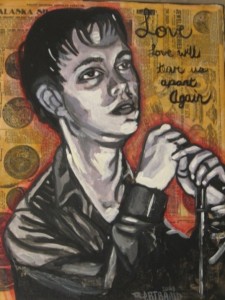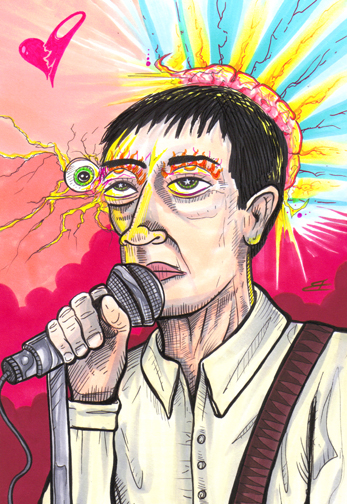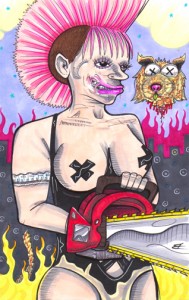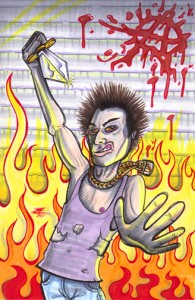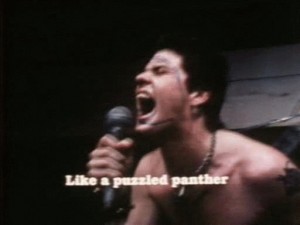 1980 was a happening year for rock star martyrdom, and Darby Crash was more than willing to give up his miserable life for that sort of immortality. Sacrifice is just part of the martyr deal. He would spill his blood for the sake of punk rock, and the whole world would adore him for it, right? After all, hadn’t that tactic worked for Sid Vicious?
1980 was a happening year for rock star martyrdom, and Darby Crash was more than willing to give up his miserable life for that sort of immortality. Sacrifice is just part of the martyr deal. He would spill his blood for the sake of punk rock, and the whole world would adore him for it, right? After all, hadn’t that tactic worked for Sid Vicious?
The Germs’ reputation spread through L.A.’s budding punk scene from their first gig in ’77. Their teenaged singer, Darby, was notorious for smearing himself with various foods and slicing himself up with broken bottles onstage. The band’s music was unlistenable for the most part—a DIY mishmash of detuned guitars and randomly beaten drums—but nobody cared so long as Crash threw his scrawny, bloody frame at the audience like a brain-damaged cat chasing shadows. In any intense romance, it’s always the thought that counts.
Darby conceived of the Germs as a sort of rock n’ roll cult. The mark of sectarian inclusion was a cigarette burn to the inside of the wrist, always administered by a prior initiate. The core crowds thrilled at Crash’s self-inflicted violence, and after awhile, newcomers began to give him some assistance.
L.A.’s early punk shows began to implode under the weight of suburban toughs looking for a brawl. Reviewing videos of the Germs’ performances, one finds the perfect target holding the microphone. These kids beat the living shit out of Darby night after night, which made for a good excuse to get loaded on heroin before going onstage. Venues eventually refused to book the Germs, which provided another good excuse to tap the vein. Being a closet homosexual in a seemingly homophobic society was yet another motivation to disappear into a boiling spoon. In the end, the sun’s continual rise and descent was reason enough for Darby to use heroin. After all, didn’t all the greatest stars turn to the red flower for inspiration?
Despite all appearances, Darby wasn’t a moron. He was an avid reader who absorbed Nietzsche alongside readings of Scientology and Buddhism. He was as fascinated by the image of Jesus as he was Sid Vicious. All of it pointed to the promise of death leading to something greater, a concept that obsessed the young punk to his early grave at twenty-one years old. He frequently spoke of his suicidal “five-year plan” to friends, but they all thought it was just another aspect of Darby’s melodramatic persona.
Germs recorded only one studio album, GI, which stood for “Germs Incognito” as the band booked themselves in venues that feared the very real possibility of the group provoking a riot. Produced by Joan Jett, it is also contains the only bearable sounds the band ever came up with. Alongside the band’s segment in the punk documentary The Decline of Western Civilization, the album remains a cult classic to this day.
The Germs opened for the likes of Devo and Blondie, and the exposure provided by Penolope Spheeris’ documentary was promising at first. But their immanent breakthrough was not enough to keep the group together. Darby hammered the final nail when he whimsically replaced the band’s drummer with his man-lover. In 1980, the Germs split and went their own directions. According to the brief biography, Wild-Eyed Boy, Darby absconded to England with his sugar mama and supposed lover, Amber.
AC/DC’s Bon Scott had been found dead of alcohol poisoning in London in February of that same year, and Led Zeppelin’s John Bonham would go in much the same way a few miles north later on in September. Neither of these death’s went unnoticed, but most likely it was Ian Curtis’ suicide in May of 1980 that got Darby thinking about his future. After Curtis’ death, Joy Division’s “Love Will Tear Us Apart” shot to the top of the charts. Suicide was a costly marketing ploy, but goddamn, it worked! The clock was ticking on Darby’s five-year plan.
The Germs played their final gig on December 3, 1980 at the Starwood in L.A. It was a rather lackluster show with a disappointing turn-out. The guitarists jokingly broke into the throbbing riff from Queen’s “Another One Bites the Dust” with no idea of the significance.
On the morning of December 7, 1980, Darby and his new “girlfriend” Casey Cola retreated to a coach house behind her parents’ place with $400 worth of smack. It is assumed that he doctored the dose to leave Casey alive, because she woke up to find him laying cold and blue beside her. According to legend, a note was scrawled on the wall that read “Here lies Darby C”, left incomplete as the singer drifted away. Another legend claims that his arms were splayed in a crucifix position. Whether this is true is irrelevant. The symbolic intention was certainly there.
Darby Crash killed himself to attract the eyes of the world, and for the whole day of December 7, he had fans in the palm of his hand. It was a short-lived adulation, though. John Lennon was shot the next day. Even in death, Darby’s timing was as off as the Germs’ worst drum solo.
© 2011 Joseph Allen
Germs — “Manimal”
1979
